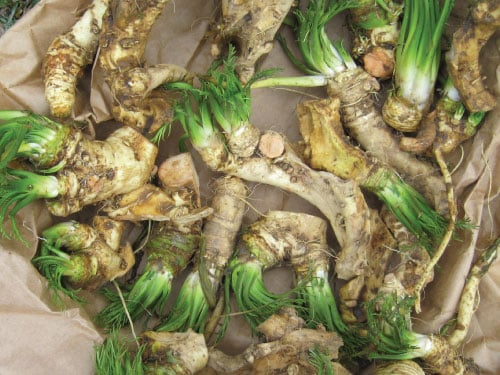
Learning Download: How to Grow Horseradish
From Seed to Harvest: A guide to growing horseradish
Homegrown horseradish is bursting with flavor, and it’s a perennial that many gardeners enjoy implementing in their garden plans each year. Horseradish has several health benefits as well, such as aiding in weight loss, helping to lower blood pressure, build strong bones, improve an immune system, promote a healthy heart, stimulate healthy digestion and more. Homegrown horseradish has a fresh, bright flavor — more so than compared to the horseradish purchased from a store.
To plant:
There are two types of horseradish — common horseradish which has broad, crinkled leaves and Bohemian horseradish, which has smoother, narrower leaves. When picking a spot to plant your horseradish, make sure it’s the spot you will continue to grow the horseradish in for a long time because once the perennial is planted, you won’t want to move it. Horseradish can be grown from root cuttings which are set out in the fall or the spring. Cut off the top third of the root, and then save the bottom part. Loosen soil 12 inches deep and add in some compost. Plant the cutting at a 45-degree angle, and leave the top of the root around 2 inches below the soil line. If you want more than one plant, space the root cuttings 30 inches apart in the garden.
To grow:
Horseradish does best when grown in full sun, but it will tolerate partial shade. It can tolerate nearly any soil, except it won’t survive in soil that is waterlogged. Other than watering horseradish once a week, it doesn’t require much attention to grow. You can also add some mulch around the plant to help retain moisture during dry spells.

Horseradish spreads very easily, so to keep it from sprawling, remove the entire root and all the branches when harvesting. Then, replant only the amount of plants you want for the following season. Do not put the horseradish in your compost, or till the ground where it previously grew, because it may spread throughout your entire garden that way.
To harvest:
Horseradish can be harvested one year after you planted the root. Harvest the horseradish after frost has killed the leaves, and harvest it by freeing the main and side roots. Scrub the dirt from the main root under running water and dry it well. Keep it in a perforated plastic bag, and horseradish can keep up to three months if stored in the vegetable drawer in your refrigerator.
What horseradish craves:
Horseradish spreads and grows very easily, so it doesn’t require much fertilizer to get started. To keep the plant healthy, add a low-nitrogen fertilizer before and after its growing season.
Where to buy horseradish roots:
You can find horseradish roots at Urban Farmer.
Learning Download: Common pests and diseases: Horseradish
Common pests and diseases: Horseradish
When growing vegetables, it is always exciting to care for the plant throughout its growing phase and then harvest it for delicious recipes later on, but one thing to watch out for is pests and diseases. Different plants are susceptible to different types of pests and diseases, and it is important to make yourself aware so you can keep a watchful eye and also take any preventative methods to keep your plants safe throughout their lifespan.
Horseradish can fall victim to several different pests and diseases.
Pests:
Some of the common pests affecting horseradish plants include the cabbage looper and flea beetle.
Cabbage loopers will cause holes in the leaves that can be small or large. The caterpillars are green and have white lines on each side of their body. Handpick the larvae from the plants, or apply Bacillus thuringiensis to kill the younger larvae.
Flea beetle will cause small holes in leaves, especially for younger plants or seedlings. This can reduce the plant’s growth and even kill the plant if damage is severe enough. Apply mulch to prevent the beetles from reaching the soil’s surface and apply neem oil to help organically control the problem.
Diseases:
Bacterial leaf spot, brittle root, Cercospora leaf spot, Ramularia leaf spot and others are diseases that commonly affect the horseradish plant.
Bacterial leaf spot will create translucent spots on the leaves and the spots then turn black and will spread across the leaves’ surface. This will eventually cause the leaves to curl up and die. The spots will grow after lots of rain. The disease prefers hot weather. To prevent this disease, remove debris from around your plants while they grow and immediately after harvest to prevent the disease from overwintering.
Brittle root will inhibit the plant’s growth, and it will cause chlorotic leaves which collapse and dry out. The roots of the horseradish plant will become brittle, and they will be discolored. Use insecticides to prevent beet leafhoppers, which transmit the disease. It is one of the most destructive diseases for horseradish.
Cercospora leaf spot will cause tan spots with a lighter center on the leaves. This leads to the leaves dying and the plant will be defoliated. Remove infected plants immediately and destroy them to prevent further spread of the disease. To prevent this disease, avoid working with the plants when they are wet. Treat seeds with hot water to eliminate the fungus prior to planting them.
Ramularia leaf spot will first appear as a yellow-green circular patch between the leaves’ veins. The lesions’ centers will dry out and drop from the plant. The entire leaf will dry out if the infection is severe enough. To prevent this disease, remove weeds and debris from around the plants and don’t use sprinklers. If you notice an infected plant, destroy it immediately. Practice crop rotation.
